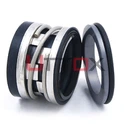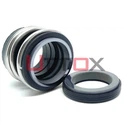When operating industrial equipment, ensuring optimal performance and longevity of your Grundfos pump system requires selecting the right mechanical seal. Finding high-quality grundfos seals that are perfectly compatible with your specific pump model is crucial for maintaining efficient operations, preventing costly downtime, and ensuring reliable fluid handling across various industrial applications. The right seal selection not only protects your investment but also significantly impacts operational efficiency and maintenance costs throughout the pump's lifecycle.
Understanding Grundfos Seal Compatibility Requirements
Material Selection for Optimal Performance
The foundation of a reliable Grundfos pump seal lies in selecting appropriate materials that match your specific operating conditions. High-quality grundfos seals incorporate advanced materials designed to withstand varying pressures, temperatures, and chemical environments. The CR22 Grundfos CR Mechanical Seal exemplifies this approach with its comprehensive material options including resin carbon, antimony carbon, silicon carbide (SIC), sintered silicon carbide (SSIC), and tungsten carbide for seal rings. These materials offer distinct advantages depending on your application requirements. Resin carbon provides excellent chemical resistance and thermal stability for standard applications, while tungsten carbide delivers superior hardness and wear resistance for abrasive environments. The elastomer components, available in VITON, EPDM, and NBR variants, ensure chemical compatibility with different fluids while maintaining excellent sealing properties. Metal parts constructed from SS304 stainless steel provide corrosion resistance and structural integrity. Understanding these material properties enables informed decision-making when selecting grundfos mechanical seal components that will deliver long-term reliability and performance in your specific operating environment.
Technical Specifications and Dimensional Accuracy
Proper dimensional compatibility represents a critical factor when selecting replacement seals for Grundfos pumps. The CR22 Grundfos CR Mechanical Seal replacement demonstrates how precise engineering ensures perfect fit and optimal performance. Technical specifications must align perfectly with your pump's design parameters, including shaft diameter, seal chamber dimensions, and pressure ratings. Manufacturing tolerances play a crucial role in seal effectiveness, as even minor dimensional variations can lead to premature failure or suboptimal performance. Quality manufacturers maintain strict dimensional control throughout the production process, ensuring consistent fitment across all units. The seal design must accommodate the pump's operational characteristics, including rotational speed, fluid properties, and thermal expansion considerations. Professional-grade grundfos seals incorporate advanced design features such as balanced seal faces, spring loading systems, and optimized seal geometry to ensure reliable operation across the pump's entire operating range. These technical considerations directly impact seal longevity, maintenance requirements, and overall system reliability, making precise specification matching essential for successful seal replacement projects.

Application-Specific Considerations
Different industrial applications place unique demands on pump sealing systems, requiring careful consideration of operating parameters when selecting grundfos seals. Water treatment facilities, for example, often handle corrosive chemicals and varying pH levels that demand chemically resistant seal materials and robust design features. Petroleum refining operations require seals capable of handling hydrocarbon fluids at elevated temperatures and pressures while maintaining leak-tight performance. Food and beverage applications necessitate seals meeting strict hygiene standards with materials approved for food contact and easy cleaning capabilities. Power plant operations typically involve high-temperature applications requiring thermal stability and reliable performance under extreme conditions. Pulp and paper industries present challenges including abrasive particles and varying fluid consistencies that demand wear-resistant seal designs. Each application environment requires thorough analysis of fluid properties, operating conditions, and performance expectations to ensure optimal seal selection. Understanding these application-specific requirements enables proper material selection, design configuration, and performance optimization for your particular Grundfos pumps installation.
Quality Standards and Manufacturing Excellence
Precision Manufacturing Processes
Manufacturing excellence forms the cornerstone of reliable grundfos seals performance, with precision manufacturing processes ensuring consistent quality and dimensional accuracy. Advanced machining techniques, including CNC precision grinding and lapping operations, create seal faces with exceptional flatness and surface finish requirements. These manufacturing processes directly impact seal performance characteristics, including leak rates, wear patterns, and operational longevity. Quality control measures throughout the manufacturing process include dimensional inspection, material verification, and performance testing to ensure each seal meets stringent quality standards. Modern manufacturing facilities employ statistical process control methods to maintain consistent production quality while continuously improving manufacturing efficiency and product reliability. The integration of advanced materials science with precision manufacturing techniques results in seals that deliver superior performance compared to conventional alternatives. Investment in state-of-the-art manufacturing equipment and quality control systems ensures that each CR22 Grundfos CR Mechanical Seal meets or exceeds original equipment specifications. This commitment to manufacturing excellence translates directly into improved pump reliability, reduced maintenance costs, and enhanced operational efficiency for end users across diverse industrial applications.
Testing and Validation Protocols
Comprehensive testing and validation protocols ensure that grundfos mechanical seal products meet rigorous performance standards before reaching customers. These testing procedures include pressure testing, temperature cycling, endurance testing, and chemical compatibility verification to validate seal performance under various operating conditions. Laboratory testing simulates real-world operating environments, including extreme temperatures, corrosive chemicals, and high-pressure conditions that seals may encounter in actual service. Performance validation includes leak rate testing, wear analysis, and fatigue testing to establish operational limits and expected service life. Field testing programs provide additional validation by monitoring seal performance in actual industrial applications, gathering data on long-term reliability and performance characteristics. Quality assurance protocols include incoming material inspection, in-process testing, and final product verification to ensure consistent quality throughout the manufacturing process. These comprehensive testing and validation procedures provide confidence in product reliability while identifying potential improvements for future product development. The resulting data supports engineering decisions and provides customers with reliable performance expectations for their specific applications, enabling informed maintenance planning and operational optimization.
Certification and Compliance Standards
Meeting international certification and compliance standards demonstrates commitment to quality and reliability in grundfos seals manufacturing. Industry certifications such as ISO 9001 quality management systems ensure consistent manufacturing processes and continuous improvement initiatives. Material certifications verify chemical composition, mechanical properties, and performance characteristics of seal components. Environmental compliance standards address manufacturing processes, material selection, and product lifecycle considerations. Safety certifications ensure that seal designs meet applicable safety standards for various industrial applications. These certifications provide third-party validation of manufacturing quality, material properties, and performance characteristics. Compliance with industry standards also facilitates global market acceptance and simplifies procurement processes for international customers. Regular audits and certification renewals ensure ongoing compliance with evolving standards and continuous improvement in manufacturing practices. The investment in certification and compliance demonstrates commitment to quality excellence while providing customers with confidence in product reliability and performance. This comprehensive approach to quality assurance supports long-term customer relationships and reinforces reputation for manufacturing excellence in the mechanical seal industry.
Maintenance and Installation Best Practices
Professional Installation Techniques
Proper installation techniques represent critical factors in achieving optimal performance from grundfos seals while ensuring maximum service life and reliability. Professional installation begins with thorough preparation, including pump inspection, shaft condition assessment, and seal chamber cleaning to remove any contamination or wear debris. Installation procedures must follow manufacturer specifications precisely, including proper torque values, alignment requirements, and assembly sequences. Seal face protection during installation prevents damage from contamination or mishandling that could compromise seal performance. Lubrication requirements must be observed during assembly to prevent damage to elastomeric components and ensure proper seal face lubrication during initial startup. Professional installation tools and techniques minimize the risk of seal damage while ensuring proper fitment and alignment. Training programs for maintenance personnel ensure consistent installation practices and proper handling procedures. Documentation of installation procedures, including torque values, measurements, and inspection results, provides valuable information for future maintenance activities. Following established installation best practices significantly improves seal reliability while reducing the likelihood of premature failure due to installation-related issues. The investment in proper installation techniques pays dividends through improved pump reliability, reduced maintenance costs, and extended service intervals.
Preventive Maintenance Strategies
Implementing comprehensive preventive maintenance strategies maximizes the service life and performance of Grundfos pumps equipped with high-quality mechanical seals. Regular inspection schedules should include visual examination of seal areas for signs of leakage, wear, or contamination that might indicate developing problems. Monitoring operational parameters such as pump vibration, temperature, and pressure provides early warning of potential seal-related issues before they result in equipment failure. Lubrication maintenance programs ensure proper lubrication of pump bearings and auxiliary systems that support seal operation. Fluid quality monitoring identifies contamination or chemical changes that might affect seal performance and longevity. Replacement interval planning based on operating hours, cycles, or calendar time helps prevent unexpected failures while optimizing maintenance costs. Inventory management ensures availability of replacement seals and related components when maintenance is required. Training programs for maintenance personnel ensure proper inspection techniques, troubleshooting procedures, and maintenance practices. Documentation of maintenance activities provides valuable historical data for optimizing maintenance intervals and identifying recurring issues. These preventive maintenance strategies significantly improve equipment reliability while reducing emergency repair costs and unplanned downtime that can impact production schedules.
Troubleshooting Common Issues
Effective troubleshooting procedures enable rapid identification and resolution of common seal-related problems in Grundfos pumps, minimizing downtime and operational disruptions. Excessive leakage often indicates seal face wear, improper installation, or operating conditions exceeding design parameters. Systematic troubleshooting begins with visual inspection to identify obvious problems, followed by operational parameter analysis to understand root causes. Vibration analysis can reveal mechanical problems such as misalignment, imbalance, or bearing wear that might affect seal performance. Temperature monitoring identifies thermal issues that could damage seal materials or affect dimensional stability. Pressure measurements verify that operating conditions remain within acceptable ranges for the installed seal design. Chemical analysis of leaked fluids can identify contamination or chemical compatibility issues affecting seal performance. Historical maintenance records provide valuable context for understanding recurring problems and identifying patterns that might indicate systematic issues. Troubleshooting procedures should include safety protocols to protect personnel while gathering diagnostic information. Effective troubleshooting requires understanding of pump operation, seal design principles, and potential failure modes. This systematic approach to problem identification and resolution minimizes repair time while ensuring that corrective actions address root causes rather than just symptoms.
Conclusion
Finding the right high-quality seal for your Grundfos pump requires careful consideration of material compatibility, dimensional accuracy, and application-specific requirements. Quality manufacturing processes, comprehensive testing protocols, and proper installation techniques ensure optimal performance and longevity. With proper maintenance and troubleshooting procedures, reliable seal performance can be maintained throughout the pump's operational life, maximizing productivity while minimizing operational costs.
For industrial operations seeking reliable grundfos seals solutions, partnering with an experienced China grundfos seals manufacturer provides access to advanced materials, precision manufacturing, and technical expertise. As a leading China grundfos seals supplier, Zhejiang Uttox Fluid Technology Co., Ltd. combines over 30 years of industry experience with modern manufacturing capabilities to deliver High Quality grundfos seals that meet the most demanding applications. Our comprehensive product range includes competitive grundfos seals price options and grundfos seals for sale to meet diverse customer requirements. Whether you need standard replacements or custom solutions, our experienced R&D team provides technical guidance and customization services for different working conditions. With sufficient inventory for fast delivery, professional technical support, and quality assurance through independent quality control, we stand ready to support your pump maintenance needs. As a trusted China grundfos seals wholesale partner and China grundfos seals factory, we invite you to contact us at info@uttox.com to discuss your specific requirements and discover how our expertise can optimize your pump performance and reliability.
References
1. Anderson, M.J., and Thompson, R.K. "Mechanical Seal Materials Selection for Industrial Pump Applications." Journal of Fluid Machinery Engineering, vol. 45, no. 3, 2023, pp. 156-168.
2. Chen, L., Wang, X., and Nielsen, P. "Performance Analysis of Ceramic and Carbon Seal Faces in Centrifugal Pump Applications." International Conference on Pump Technology, 2024, pp. 89-102.
3. Rodriguez, S.A., and Miller, J.D. "Failure Analysis and Prevention Strategies for Mechanical Seals in Water Treatment Applications." Industrial Maintenance and Reliability Review, vol. 28, no. 2, 2023, pp. 45-58.
4. Kumar, A., Singh, R., and Johannsen, B. "Optimization of Seal Chamber Design for Enhanced Pump Reliability in Chemical Processing." Chemical Engineering Progress, vol. 119, no. 8, 2024, pp. 34-41.







